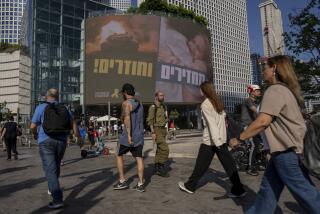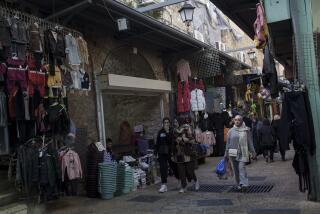Picturing Israel’s Past and Present
- Share via
The photographer must approach old Jerusalem, the heart of Israel, with an awareness of the past and an appreciation of the present.
Religious feelings run deep, and you’ll find some restrictions on photography. These restrictions are varied and inconsistent, but courtesy requires that you observe posted signs about photography and respond to verbal requests not to use your camera.
It is useful to know that picture taking is not allowed at the Western Wall on the Jewish Sabbath, but there is no restriction from behind the metal rail on other days. Photography inside the Dome of the Rock is not allowed, but the outside golden dome and blue mosaic facade can be photographed freely and seem to be designed with color film in mind.
Even flash photography is allowed in the Church of the Holy Sepulchre; the Greek Orthodox priests with their incense pots and the ornate altars are fascinating subjects.
Jerusalem’s Bazaars
We were impressed by the bazaars of the old city in Jerusalem. These teeming markets are crowded and filled with picture possibilities. Brass and copper containers and samovars glisten in the warm light of incandescent bulbs. Baskets of spices, cloves and saffron are filled to the brim, rich circles of color and texture.
Turbaned men and veiled women walk through the dimly-lit corridors, shafts of dust-laden sunlight filtering from openings above. This is another world, separated from modern Israel by ancient, fortified walls and nearly 2,000 years.
The light presents problems because it changes from bright sunlight to open shade and to marginal light as one walks through the narrow streets and walkways.
We found it helpful to have two cameras each, one loaded with Kodachrome 64 and the other with Ektachrome 400. A small table-top tripod allowed us to brace our cameras against walls for longer exposures up to one full second.
Basic Precautions
It is wise to take some basic precautions to protect your cameras in the crowds of the bazaar. Never put down your camera bag, and carry the cameras you are using with the strap around your neck and not over your shoulder.
We carried our bags with the Velcro flaps fastened and turned against our bodies to keep them from being opened without our knowledge. These are precautions we take in any crowded marketplace; theft is quite rare in Israel. It is a country that has proved its ability to keep order in its own house.
Two hours south of Jerusalem by car is Masada, the mountain stronghold where a handful of Jewish zealots held out against the Roman legions and committed mass suicide in preference to surrender. It gives one a ghostly feeling to walk among these windswept ruins and gaze across the Dead Sea to the hills of Jordan.
Within sight and a 10-minute ride from the base of Masada the legendary Dead Sea shimmers in the afternoon sun, beckoning and seductive to the tired and thirsty traveler. At 1,292 feet below sea level, it is the lowest place on Earth.
The Deadly Dead Sea
The salt- and mineral-laden water is deadly poison when taken internally, but paradoxically is medically beneficial when used externally for various skin ailments. The major attraction, however, is just the simple pleasure of floating on the surface of the almost gelatinous water where you bob like a cork.
It is vital to protect your cameras from even a single drop of water from the Dead Sea. This liquid is highly corrosive and even a small amount can destroy the mechanism of an expensive camera in minutes.
There is much more to Israel than Jerusalem and a salty sea. Many visitors drive on to Eilat and the Red Sea; others go on to the sparkling, cosmopolitan city of Tel Aviv with its world renowned Israeli Philharmonic Orchestra and Tel Aviv University. It would take a lifetime to absorb and photograph what this vibrant country has to offer.
The visiting photographer will find it a challenge to try to capture with his lens the excitement of the Israel of today and the richness of the Israel of the past. And as the guides in Jerusalem like to say if it is raining: “Pray for sun. From here, it is only a local call.”
More to Read
Sign up for The Wild
We’ll help you find the best places to hike, bike and run, as well as the perfect silent spots for meditation and yoga.
You may occasionally receive promotional content from the Los Angeles Times.






